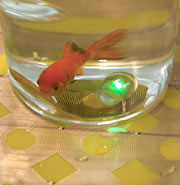
This table can power a light placed above it — even one that's underwater.
Annoyed by the tangle of power cords under
your desk? A sheet of plastic invented by researchers in Japan could one
day make for tables and walls that power devices placed on them — without
any need for wires or plugs. Computers could be powered through the desks
on which they sit, for example, or flat-screen televisions through the
walls where they hang.
The team of seven researchers at the University
of Tokyo has produced a sample sheet of the plastic, which is about the
size of a very thin magazine — just one millimetre thick and weighing 50
grams. It can deliver up to 40 watts of power to products on or near it
that contain a special 'receiving coil': enough to power a lightbulb or
a very small laptop. They say that scaled-up production of such sheets
could be inexpensive enough for widespread installation in desks, floors,
ceilings and walls, ushering in a "new class of electronic devices".
The plastic, described today in Nature Materials1,
has as its base a layer of transistor featuring pentacene, an organic molecule
whose electrical conductivity can be controlled. Topping that are layers
holding copper coils that can sense whether a compatible electronic device
is nearby, microelectromechanical-system (MEMS) switches that serve to
turn on and off the power, and copper coils to transmit electricity.
When the sheet itself is plugged in, it can
power devices — such as light-emitting diodes (LEDs) strung on a Christmas
tree — that are built with a matching receiver coil. When these are placed
within 2.5 centimetres of the sheet, the nearest MEMS switch turns on,
feeding power to the closest sender coil, which powers the device's receiving
coil through induction. |
The researchers say the transmission of power
happens with 81.4% efficiency — compared to 93% efficiency in the wired
grid network as a whole — with a "quite low" level of leaked electromagnetic
radiation. As a demonstration of the product's safety, the paper shows
it powering an LED at the bottom of a bowl containing water and a live
fish.
All four layers are produced by literally
printing them — the coils using screen printing, the switch and transistor
layers with an ink-jet printer (using special electronic inks). So the
product is thin, lightweight and mechanically flexible.
Power pad
Wireless power systems are nothing new: many
electric toothbrushes are charged wirelessly by standing them in a powered
base where electrical contacts come in touch with each other, for example.
And several companies offer power 'pads' that, when plugged in, will charge
specially developed devices, such as compatible mobile phones, simply by
placing them anywhere on the pad's surface. But these use silicon-based
transistors, which are harder to manufacture and so are more expensive.
Printable organic transistors can theoretically be made of any size, at
a considerably lower cost.
Roger T. Howe, an electrical engineer at Stanford
University in Palo Alto, California, is impressed by the work. "The demonstration
of both organic transistors and MEMS switches in a useful system makes
it impressive," he says.
But don't throw out your power cords yet:
the researchers say that these plastic power sheets probably won't hit
the market for 5 years, while they improve their reliability and stability.
However, they have received "lots of feedback from many companies",
and project a target manufacturing cost of US$100 per square metre. Then
there's still the trick of getting device manufacturers to put the receiving
coils into their products to make them compatible. But should that happen,
you may someday enjoy a world with ubiquitous power — and no power cords.
References
1. Sekitani T., et al. Nature Materials, advance
online publication; doi:10.1038/nmat1903 (2007). |
